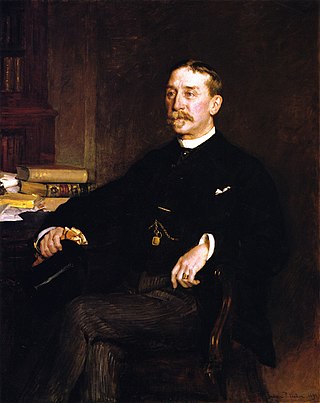
Gilbert Stuart was an American painter born in the Rhode Island Colony who is widely considered one of America's foremost portraitists. His best-known work is an unfinished portrait of George Washington, begun in 1796, which is usually referred to as the Athenaeum Portrait. Stuart retained the original and used it to paint scores of copies that were commissioned by patrons in America and abroad. The image of George Washington featured in the painting has appeared on the United States one-dollar bill for more than a century and on various postage stamps of the 19th century and early 20th century.

James Freeman Clarke was an American minister, theologian and author.

Joseph Blackburn, also known as Jonathan Blackburn, was an English portrait painter who worked mainly in Bermuda and in colonial America. His notable works include portraits of Hugh Jones and Colonel Theodore Atkinson.

Mather Brown was an American painter who was born in Boston, Massachusetts and was active in England.

George Fuller was an American figure and portrait painter.

Joseph Henry Walker was a member of the United States House of Representatives from Worcester, Massachusetts.

Augustus Vincent Tack (1870–1949) was an American painter of portraits, landscapes and abstractions.

Peter Pelham was an American portrait painter and engraver, born in England.
Samuel Hill was an engraver who worked in Boston, Massachusetts, in the late 18th and early 19th centuries. His engravings were published in the Massachusetts Magazine; Defoe's New Robinson Crusoe (1790); Lavater's Essays on Physiognomy (1794); American Universal Geography (1796); Cook's Three Voyages to the Pacific Ocean (1797). Hill's subjects extended from maps to literary illustrations to landscapes; portrait subjects included James Bowdoin, Rev. John Murray of Newburyport, Massachusetts, and Elizabeth White. Examples of Hill's work can be found in the American Antiquarian Society, Massachusetts Historical Society, and Museum of Fine Arts, Boston.

Ethan Allen Greenwood (1779–1856) was an American lawyer, portrait painter, and entrepreneurial museum proprietor in Boston, Massachusetts, in the early 19th century. He established the New England Museum in 1818.
The Boston Artists' Association (1841–1851) was established in Boston, Massachusetts by Washington Allston, Henry Sargent, and other painters, sculptors, and architects, in order to organize exhibitions, a school, a workspace for members, and to promote art "for the art's sake."

Elizabeth (Eliza) Goodridge was an American painter who specialized in miniatures. She was the younger sister of Sarah Goodridge, also an American miniaturist.

Thomas Edwards (1795–1869) was an artist in 19th-century Boston, Massachusetts, specializing in portraits. Born in London and trained at the Royal Academy, he worked in Boston in the 1820s-1850s, and in Worcester in the 1860s.

Stephen Salisbury III (1835–1905), also referred to as Stephen Salisbury Jr., was an American businessman, lawyer, and politician. The son of a wealthy landowner, Salisbury helped manage the family's extensive properties and businesses in Worcester County, Massachusetts. Like his father, Salisbury served in the State Senate, was president of the Worcester National Bank, and directed the Worcester & Nashua Railroad. He was a trustee of the Worcester City Hospital and the Worcester Polytechnic Institute.
Christian Gullager was a Danish-American artist specializing in portraits and theatrical scenery in the late 18th century. He worked in Boston, Massachusetts, New York, and Philadelphia.

William Massey Stroud Doyle (1769–1828) was a portrait painter and museum proprietor in Boston, Massachusetts.
Augustine H. Folsom or A.H. Folsom was a photographer in the Boston, Massachusetts-area in the late 19th and early 20th centuries. Subjects included buildings in Massachusetts, Maine, and Georgia. Folsom showed photographic work in the Massachusetts Charitable Mechanic Association exhibitions of 1874 and 1881. He lived in Roxbury, c. 1870–1926. Works by Folsom reside in the collections of the Boston Public Library; Historic New England; Metropolitan Museum, NY; Museum of Fine Arts, Boston; the Georgia State Archives; and the American Antiquarian Society.

Frank Hill Smith (1842–1904) was an American artist and interior designer based in Boston, Massachusetts. He painted landscapes and figures; and designed wall frescos, stage curtains, stained-glass windows, and other décor. Among his works are ceiling frescoes in the Representatives Hall in the Massachusetts State House.

Ruth Henshaw Bascom, also known as Aunt Ruth, was an American folk artist who produced over 1,400 portraits. She was the daughter of Colonel William Henshaw and Phebe Swan of Leicester, Massachusetts, and a schoolteacher from 1791 to 1801. Bascom married first, at about 32 years of age, to Dr. Asa Miles, but he died a year or more after their marriage. She married a second time for about 35 years to Reverend Ezekial Lysander Bascom. Bascom didn't give birth to children of her own, but she had a stepson from her first marriage, stepdaughter from her second marriage, and a niece and nephew that she raised. She documented the daily activities of her life in diaries beginning at the age of 17, which included records of the portraits that she made.

Lawrence Park was an American art historian, architect, and genealogist who authored pioneering critical and biographical studies of portrait painters Gilbert Stuart, Joseph Badger, and Joseph Blackburn, active during the colonial and early federal periods of the United States. Park's four-volume treatise on Stuart was published posthumously in 1926. Park's papers are held at the Winterthur Library and the Frick Art Reference Library.





















